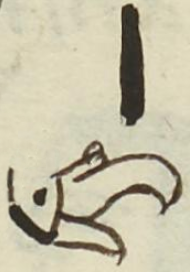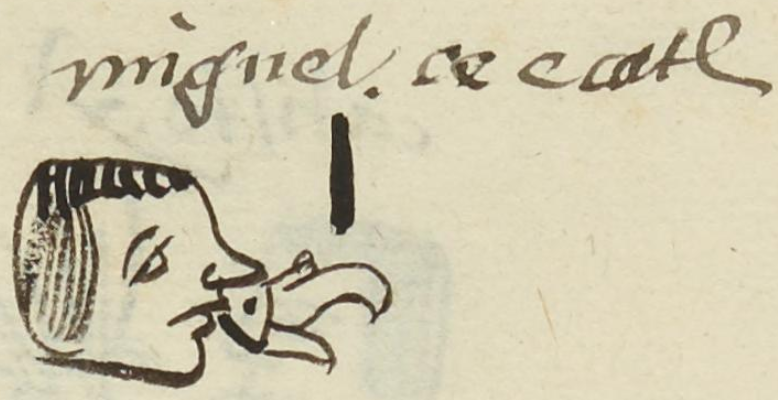Ce Ecatl (MH665v)
This black-line drawing of the simplex glyph for the personal name Ce Ecatl (“One Wind” or “1-Wind”) is attested here as a man’s name. The glyph involves a wind-blowing device associated with the divine force of the wind (Ehecatl) on the very mouth of the tribute payer. In this case, the device looks more like the beak of a bird, perhaps a parrot, but it must intend the buccal mask through which Ehecatl was believed to blow the wind. Above this beak is a vertical black line that serves as the number 1. Ehecatl is a day name from the 260-day religious divinatory calendar, the tonalpohualli.
Stephanie Wood
Originally, the number one would have been shown with a small circle, so this notation shows European influences. Calendrical names were discouraged by the clergy, so it is important to note that they were still being used to some extent in 1560, roughly four decades after the Spanish invasion and seizure of power in Mexico.
Stephanie Wood
1560
Jeff Haskett-Wood
nombres de días, números, notaciones, fechas, calendarios, viento, aliento, aire, nombres de hombres, ave, aves, pájaro, pájaros, pluma, plumas

ce, one, https://nahuatl.wired-humanities.org/content/ce
eca(tl), air or breath, https://nahuatl.wired-humanities.org/content/ecatl
eheca(tl), wind or the divine force of the wind, https://nahuatl.wired-humanities.org/content/ehecatl
Uno Viento, o 1-Viento
Stephanie Wood
Matrícula de Huexotzinco, folio 665v, World Digital Library, https://www.loc.gov/resource/gdcwdl.wdl_15282/?sp=411&st=image.
This manuscript is hosted by the Library of Congress and the World Digital Library; used here with the Creative Commons, “Attribution-NonCommercial-ShareAlike 3.0 License” (CC-BY-NC-SAq 3.0).






